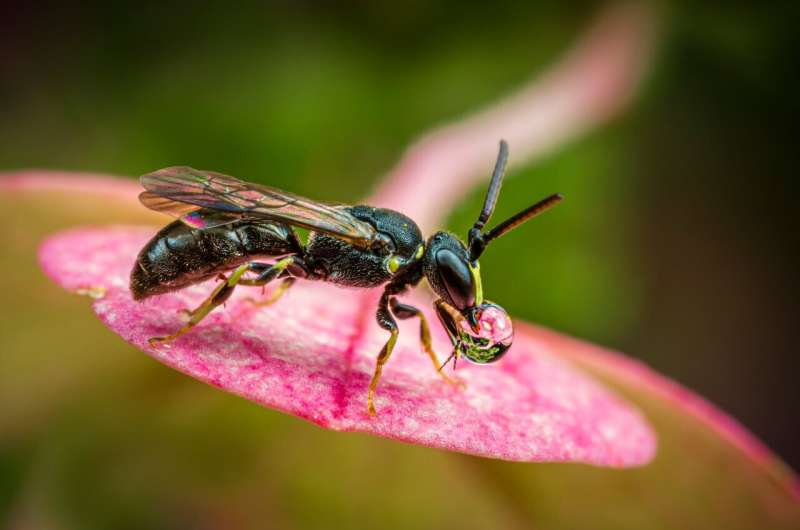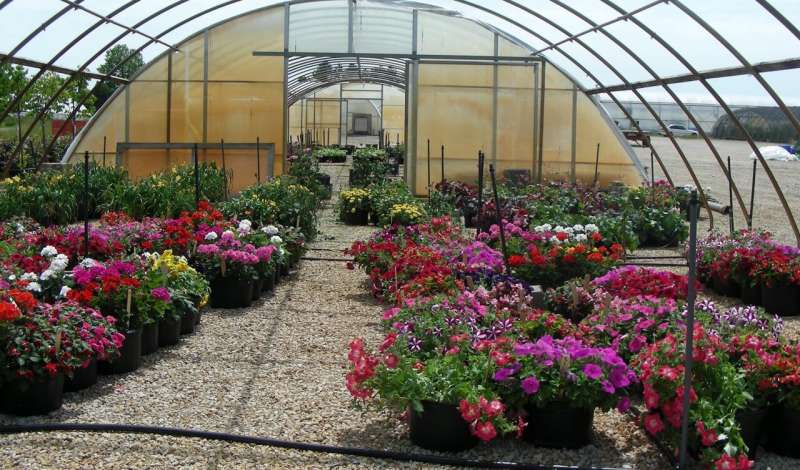This article has been reviewed according to Science X's editorial process and policies. Editors have highlighted the following attributes while ensuring the content's credibility:
fact-checked
peer-reviewed publication
trusted source
proofread
Two-year study shows some varieties of annual flowers have a place in pollinator-friendly gardens

While wildflowers and perennials are a must for supporting pollinators, there's no denying the popularity of many annual flowers for their colorful, visual appeal. Annuals are often thought of as pollinator "deserts," but a new study suggests choosing the right varieties can give annual flowers a role in nourishing bees and other pollinating insects in home gardens.
In a two-year study, researchers at Michigan State University observed pollinators visiting 25 different varieties, or cultivars, of the six most popular annual flower species in the United States, finding significant variation in apparent pollinator attractiveness between cultivars, even within the same flower species. Two begonia cultivars, "Cocktail Brandy" and "Ambassador Rose Blush," and the impatiens cultivar "Accent Coral" drew in the most pollinating insects among all those tested. Results of the study are published in the Journal of Economic Entomology.
"For homeowners and other customers of garden centers, it means that they can choose cultivars of some of their favorite flowers that provide some support for pollinators," says David Smitley, Ph.D., professor emeritus in the Department of Entomology at Michigan State University (MSU), and lead author of the study.
Popular among people, but what about pollinators?
Among all flowering plants sold at garden centers in the United States every year, more than half are annual flowers, totaling nearly $2 billion in sales value in 2020, according to data from the U.S. Department of Agriculture. Nearly half of those sales—more than $900 million—are from the top six annuals: petunias, geraniums, pansies, begonias, impatiens, and New Guinea impatiens. (This group made up six of the top seven annuals in the United Kingdom in 2021, as well.)

These were the flowers Smitley and colleagues chose to study, driven by a lack of previous experimental research on pollinator attraction to them.
To begin to fill this knowledge gap, the team chose three to five cultivars of each of the six annual flower species, for a total of 25 cultivars, to evaluate alongside four other benchmark flower species known to be attractive to pollinators.
Smitley and MSU colleagues Colin Oniel, Erica Hotchkiss, and Erik Runkle grew six groups of the annuals (150 plants in total) in mixed plots at a horticultural facility at MSU in the summer of 2017 and again in 2018, with the benchmark species nearby. From early June to late August, the researchers visited the plots regularly to collect insects on the flowers, recording which cultivars they were visiting.
With help from bee taxonomist Jason Gibbs, Ph.D., at the University of Manitoba and statistician Jared Studyvin, Ph.D., at the University of Wyoming, the team then identified the insects to genus or species and analyzed the visitation rates to the flowers, comparing results between flower species, between cultivars within each species, and against visits to the known pollinator-friendly benchmark flowers.
Smitley says he was surprised by the results, which showed significant variation in pollinator visitation among cultivars of the same flower species and that some cultivars were attractive enough to warrant choosing for supporting pollinators in home gardens.
Variation in the varieties
Overall, pollinator visits to annual flowers were low compared to the benchmark flowers in the study. This was as expected—wildflowers and perennials maintain their strong appeal to pollinators because their nectar and pollen production hasn't been bred out of them in favor of flower appearance. But even among the annual cultivars, some showed "modest" attractiveness to pollinators, and much more than other cultivars.
For instance, the begonia cultivars "Cocktail Brandy" and "Ambassador Rose Blush" attracted pollinators at more than triple the rate of the lowest tested begonia cultivar. The impatiens cultivar "Accent Coral" was close behind. And, while even the least attractive begonia cultivar drew as many pollinators as the top-ranked geranium, among geraniums there was a similar variation in cultivars. This variation showed up in all of the species of annual flowers tested.
"Our hope is that this research will lead to the development of cultivars of popular annuals that support pollinators, so that homeowners will be able to purchase the flowers they love that are also good for pollinators," Smitley says.
Pollinating insects that visited flowers in the study included honey bees, bumble bees, sweat bees, and wasps—but also many flies in the family Syrphidae. The larvae of syrphid flies are beneficial because they eat aphid and psyllid pests, but adult syrphid flies also serve as pollinators. Butterflies, however, were excluded from the results because there were not enough butterfly visits to compare flower types. Smitley says butterfly attraction could be measured in future projects with a modified study design.
A place for annuals in the movement to protect pollinators
Of course, 25 cultivars among six species comprise just a slice of the myriad varieties of annual flowers available to consumers. More remain to be evaluated, and Smitley says the key lessons for entomologists and horticulturalists are that annual flowers can be evaluated for their support of pollinating insects and that enough variation exists among cultivars to warrant doing so.
"This research is evidence that plant breeders could begin developing and marketing pollinator-friendly cultivars of the most popular flowers," he says.
And, for gardeners, annual flowers don't have to be left out of their efforts to support pollinators. A diversity of wildflowers and native perennials is still most important, but some annual cultivars will help bees and other pollinating insects, too. And, even before more cultivars are evaluated by scientists or breeders develop more pollinator friendly cultivars, any gardener can be a citizen scientist in this realm, Smitley says.
"They can purchase a mixture of cultivars—five or more is best—and observe which ones are visited by bees," he says. "Then they will know for future years what they look like, how well they do in their garden, and how attractive they are to bees."
More information: David Smitley et al, Evaluation of the most popular annual flowers sold in the USA and Europe indicates low visitation rates by pollinators and large variation among cultivars, Journal of Economic Entomology (2024). DOI: 10.1093/jee/toae084
Journal information: Journal of Economic Entomology
Provided by Entomological Society of America




















